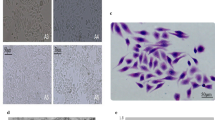Summary
The oncogenicity of the cultivated cells of C3H/He mouse salivary gland adenocarcinoma is strictly correlated with the presence of the viral particles (Bittner). From both a quantitative and a qualitative standpoint the growth of the implanted tumor is similar to that observed in vivo and completely different from the mammary gland tumor which is also produced by Bittner virus. After 180 days the viral particles disappear from the cell and thereafter the cells are no longer oncogenic when implanted in isogeneic hosts.
The early phases of culture are characterized by the epithelial feature of the tumor with a pseudotubular pattern. This feature is not modified with aging of the cultures, however a pseudo-flbroblastic transformation has occasionally been observed in very old samples. This step of evolution is characterized by “eosinophilic degeneration”.
In the evolution of in vitro-tumor a relationship appears to exist between the disappearance of virus particles, the loss of oncogenicity and the presence of eosinophilic bodies.
Zusammenfassung
Die Onkogenität von Zellen des C3H/He-Speicheldrüsen-Adenocarcinoms der Maus in Gewebekulturen ist eng verknüpft mit der Anwesenheit von Virus-partikeln (Bittner). Sowohl in quantitativer wie in qualitativer Hinsicht ist das Wachstum der implantierten Tumorzellen ähnlich dem in vivo beobachteten, jedoch vollkommen verschieden von dem des ebenfalls durch das Bittner-Virus hervorgerufenen Mammatumors. Nach 180 Tagen verschwinden die Viruspartikel aus den Zellen, wonach sie nicht mehr onkogen sind, wenn sie in isogene Wirtstiere transplantiert werden. Die frühen Phasen der Tumorzellen in der Gewebekultur sind durch epitheliale Beschaffenheit und Bildung von Pseudotubuli charakterisiert. Dieses Verhalten ändert sich auch nicht beim Altern der Kulturen, doch wurde gelegentlich eine pseudo-fibroblastische Umwandlung bei sehr alten Kulturen beobachtet. Dieser Vorgang ist durch eine „eosinophile Dengeneration” gekennzeichnet.
In der Evolution des Tumors in vitro scheint eine Beziehung zwischen Verschwinden der Viruspartikel, dem Verlust der Onkogenität und dem Auftreten von eosinophilen Körperchen zu bestehen.
Similar content being viewed by others
References
Caputo,A.: Biological properties of a new transplantable mouse submaxillary gland tumor. 46th Meeting of I.A.O.R., San Francisco (1968).
Caputo,A. and Floridi,A.: Metabolic properties of mouse transplantable adenocarcinoma. Cancer Res. 28, 2545–2547 (1968).
Caputo,A., Floridi,R., Frati,L., Castelli,L., Orci,L.: Caratteristiche di un nuovo tumore trapiantabile della ghiandola sottomascellare del topo. Congresso Soc. Ital. Patol., Roma, 225–233 (1969).
Caputo,A., Orci,L.: Morphological studies on a new transplantable salivary gland tumor in C3H mice. Z. Krebsforsch. 73, 46 (1969).
Castelli,L., Caputo,A.: Preliminary virological and immunological studies of the salivary gland tumor of C3H/He mouse. Experientia (Basel) 26, 780–781 (1970).
Dawe,C.J., Whang-Peng,J., Morgan,W.D., Hearon,E.C., Kentsen,T.: Epithelial origin of polyoma salivary rumors in mice. Evidence based on chromosome-marked cells. Science 171, 394–397 (1971).
Dmochowski,L.: Sarcomatous transformation in one tumor of each high cancer strain mice R. III, A. C3H. Amer. Rep. Yorkshire Council Brit. Empire Cancer Campaign (1950).
Dmochowski,L.: Viruses and tumors in the light of electron microscopy studies: a review. Cancer Res. 20, 977–1015 (1960).
Dunn,T.B.: Morphology of mammary tumor in mice. The Physiopathology of Cancer. II. Ed., p. 38–84. 1959.
Fasske,E., Fetting,R., Mörghenroth,K., Theman,H.: The sarcomatous transformation of mammary carcinoma of mice in isologous transplantates in cells cultures and reimplantates. Oncology 21, 189–213 (1967).
Frati,L., Caputo,A.: Caratteristiche enzimatiche di un adenocarcinoma spontaneo della ghiandola sottomascellare del topo C3H. Boll. Soc. ital. Biol. sper. 45, 568–572 (1969).
Gropp,A., Lettre,R.: Über adaptive Veränderungen der morphologischen Eigenschaften eines Mammacarcinoms der Maus. Z. Krebsforsch. 62, 616–635 (1958).
Lasfargues,E.Y., Feltman,D.G.: Hormonal physiological background in the production of B particles by the mouse mammary epithelium in organ cultures. Cancer Res. 23, 191–196 (1963).
Lasfargues,B.Y., Murray,M.R.: Mouse mammary carcinogenesis in vitro. Cancer Cells in Culture, pp. 231–240. Tokyo: University of Tokyo Press 1968.
Lasfargues,B.Y., Murray,M.R., Moore,D.H.: Cultivation of the mouse mammary adenocarcinoma virus. J. Nat. Cancer Inst. Monograph no. 4, Symposia Tumor Viruses, 151–159 (1960).
Lundford,R.J., Barlow,H.: Sarcomatous transformation of the stroma of mammary carcinoma that stimulated fibroblastic growth in vitro. Cancer Res. 5, 257–264 (1945).
Marcante,M.L., Castelli,L., Caputo,A.: Oncogenicity of a cell line derived from adenocarcinoma of the salivary gland of C3H/He mouse. Experientia (Basel) 27, 434 (1971).
Mohr,H.J.: Der Strukturwandel des spontanen Mammacarcinomas der NMRI Maus in homologen Transplant. Frankfurt. Z. Path. 73, 67–78 (1963).
Puca,G.A., Bresciani,F.: Association constant and specificy of oestradiol-receptor interaction. Nature (Lond.) 223, 745–757 (1969).
Sykes,J.A., Whitescarver,J., Briggs,L.: Observations on a cell line producing mammary tumor virus. J. nat. Cancer Inst. 41, 1315–1327 (1968).
Toolan,H.W., Kidd,J.G.: Sarcomatoid growth resulting from mammary carcinoma cells that had sojourned in immune mice. Amer. J. Path. 26, 753–754 (1950).
Tsubura,Y., Toyoshima,K., Sand,S., Watanabe,J.: Fate of B particles of mouse mammary tumor in vivo and in vitro. In: Cancer Cells in Culture, pp. 216–230. Tokyo: University of Tokyo Press 1968.
Author information
Authors and Affiliations
Rights and permissions
About this article
Cite this article
Castelli, L., Marcante, M.L. & Caputo, A. Further investigations on the behaviour of cultivated salivary gland adenocarcinoma of the mouse. Z. Krebsforsch. 79, 224–233 (1973). https://doi.org/10.1007/BF00304014
Received:
Accepted:
Issue Date:
DOI: https://doi.org/10.1007/BF00304014




